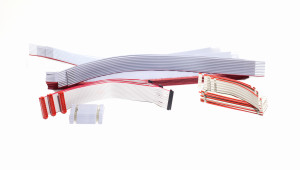The Evolution of Cable Assemblies: Innovations and Trends in the Industry
Posted on June 14, 2024 by StCross
As technology continues to advance, the cable assembly industry is experiencing significant innovations and evolving trends. This article explores the latest developments in cable assemblies and their manufacture, highlighting how these changes are shaping the future of connectivity.
The Historical Evolution of Cable Assemblies
Cable assemblies have come a long way since their inception. Initially, they were simple constructs designed to connect basic electrical systems. Over time, as technology advanced, the demand for more complex and reliable cable assemblies grew, leading to innovations in materials, design, and manufacturing processes.
Key Innovations in Cable Assembly Technology
- Advanced Materials
- High-Performance Insulation: New insulation materials offer better resistance to heat, chemicals, and physical wear, enhancing the durability and reliability of cable assemblies.
- Lightweight Conductors: The use of lightweight yet highly conductive materials, such as certain alloys, reduces the weight of cable assemblies without compromising performance.
- Automated Manufacturing
- Robotic Assembly: Automated systems and robotic machinery increase precision and efficiency in cable assembly production, reducing human error and production time.
- 3D Printing: Emerging 3D printing technologies are enabling the creation of complex connector and cable designs that were previously difficult to manufacture.
- Smart Cables
- Embedded Sensors: Integrating sensors within cable assemblies allows for real-time monitoring of performance parameters, such as temperature, voltage, and current.
- IoT Integration: Smart cables can communicate with other devices within the Internet of Things (IoT) ecosystem, providing valuable data for predictive maintenance and system optimisation.
- Customisation and Flexibility
- Modular Designs: Modular cable assemblies offer greater flexibility, allowing for easy modifications and custom configurations to meet specific application needs.
- Rapid Prototyping: Advanced design software and rapid prototyping techniques enable quicker development cycles, allowing manufacturers to bring new products to market faster.
Current Trends Shaping the Industry
- Sustainability
- Eco-Friendly Materials: There is a growing focus on using recyclable and biodegradable materials in cable assembly manufacturing to reduce environmental impact.
- Energy Efficiency: Manufacturers are developing energy-efficient production processes and products to align with global sustainability goals.
- Miniaturisation
- Compact Designs: As electronic devices become smaller, the demand for miniaturised cable assemblies that can fit into tight spaces without sacrificing performance is increasing.
- High-Density Interconnects: Advances in connector technology allow for higher density interconnections, supporting the trend towards smaller and more powerful devices.
- Enhanced Performance
- High-Speed Data Transmission: The need for faster data transfer rates in telecommunications and computing is driving the development of high-speed cable assemblies.
- Improved Shielding: Enhanced shielding techniques are being used to protect against electromagnetic interference (EMI) and ensure signal integrity.
- Global Supply Chain Adaptations
- Localised Manufacturing: To mitigate the risks associated with global supply chain disruptions, there is a trend towards localised manufacturing of cable assemblies.
- Supply Chain Transparency: Improved tracking and transparency throughout the supply chain help ensure the quality and reliability of components.
The Future of Cable Assemblies
Looking ahead, the cable assembly industry is poised for continued growth and innovation. Key areas to watch include the integration of artificial intelligence for predictive maintenance, further advancements in smart cable technology, and the ongoing push for sustainable manufacturing practices.
Conclusion
The evolution of cable assemblies reflects the broader technological advancements and shifting demands of modern industries. By staying abreast of these innovations and trends, businesses can ensure they are utilising the most advanced and reliable cable assembly solutions available. At St. Cross Electronics, we are committed to leveraging these developments to provide our clients with cutting-edge cable assembly solutions that meet their evolving needs.









